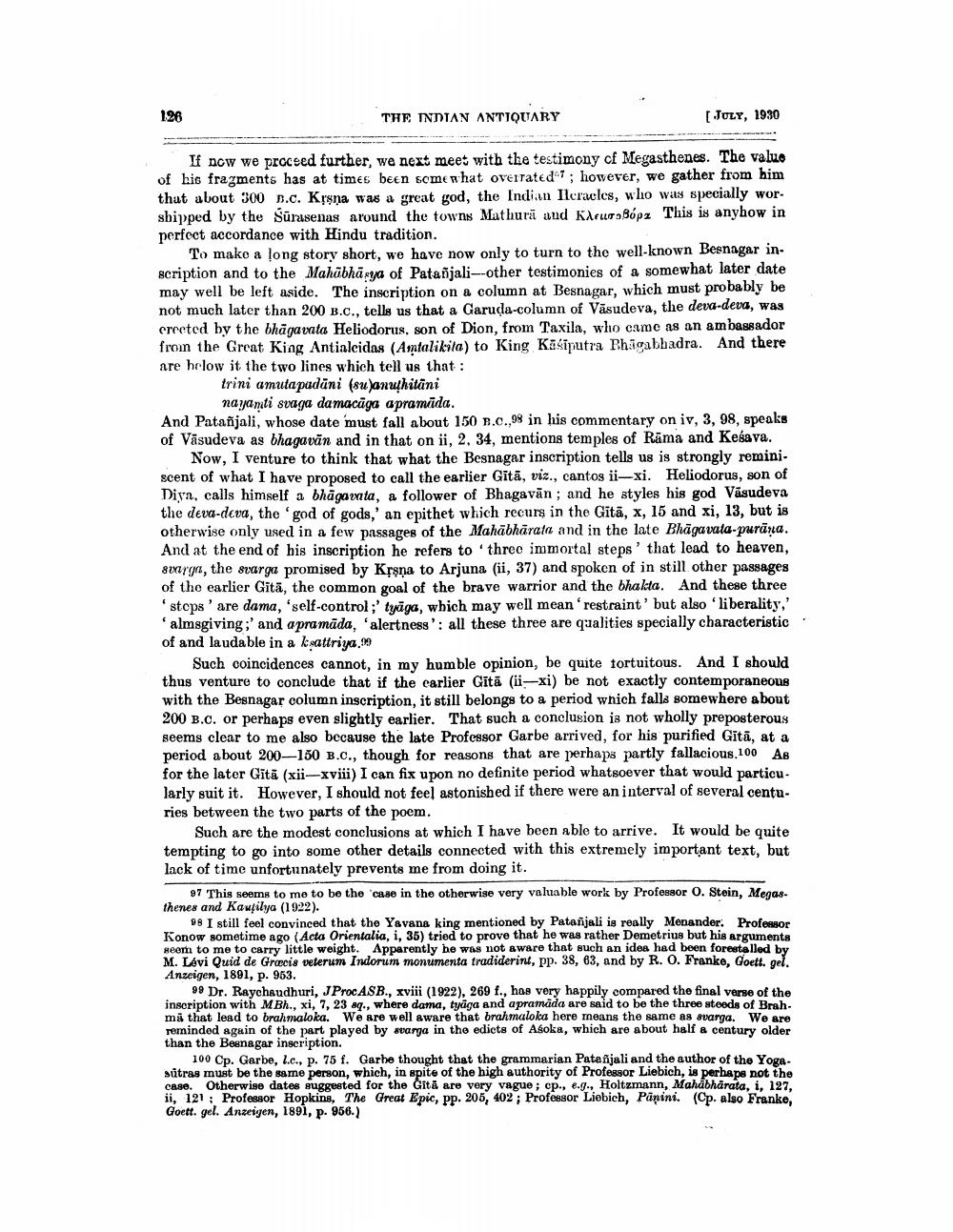________________
126
THE INDIAN ANTIQUARY
[JULY, 1930
If now we proceed further, we next meet with the testimony of Megasthenes. The value of his fragments has at times been somewhat overratedar; however, we gather from him thut about 300 D.C. Krsna was a great god, the Indian Ileracles, who was specially worshipped by the Sūrasenas around the towns Mathurā aud Kleur Bópz This is anyhow in perfoct accordance with Hindu tradition.
To make a long story short, we have now only to turn to the well-known Besnagar inscription and to the Mahābhāsya of Patañjali--other testimonies of a somewhat later date may well be left aside. The inscription on a column at Besnagar, which must probably be not much later than 200 B.C., tells us that a Garuda-column of Väsudeva, the devd-deva, was crected by the bhāgavita Heliodorus, son of Dion, from Taxila, who came as an ambassador from the Great King Antialcidas (Amtalikila) to King Käsiputra Bhagabhadra. And there are helow it the two lines which tell us that:
trini amuta padani (sulanuhitani
nayamti svaga damacīga apramida. And Patañjali, whose date must fall about 150 B.C.,98 in his commentary on iv, 3, 98, speaks of Vasudeva as bhagavān and in that on ii, 2, 34, mentions temples of Rāma and Keśava.
Now, I venture to think that what the Besnagar inscription tells us is strongly remini. scent of what I have proposed to call the earlier Gītā, viz., cantos ii-xi. Heliodorus, son of Diyn, calls himself a bhagavata, a follower of Bhagavān; and he styles his god Vasudeva the deva-deva, the 'god of gods,' an epithet which recurs in the Gitā, x, 15 and xi, 13, but is otherwise only used in a few passages of the Mahābhārata and in the late Bhagavata-purūna. And at the end of his inscription he refers to three immortal steps' that lead to heaven,
warga, the svarga promised by Krsna to Arjuna (ii, 37) and spoken of in still other passages of the earlier Gita, the common goal of the brave warrior and the bhakta. And these three
stops' are dama, 'self-control;'tyāga, which may well mean restraint' but also liberality,' almsgiving;' and a pra māda, 'alertness': all these three are qualities specially characteristic of and laudable in a knattriya.99
Such coincidences cannot, in my humble opinion, be quite tortuitous. And I should thus venture to conclude that if the earlier Gītā (ii-xi) be not exactly contemporaneous with the Besnagar column inscription, it still belongs to a period which falls somewhere about 200 B.C. or perhaps even slightly earlier. That such a conclusion is not wholly preposterous seems clear to me also because the late Professor Garbe arrived, for his purified Gitā, at a period about 200-150 B.C., though for reasons that are perhaps partly fallacious.100 AB for the later Gita (xii-xviii) I can fix upon no definite period whatsoever that would particularly suit it. However, I should not feel astonished if there were an interval of several centuries between the two parts of the poem.
Such are the modest conclusions at which I have been able to arrive. It would be quite tempting to go into some other details connected with this extremely important text, but lack of time unfortunately prevents me from doing it.
97 This seems to me to be the case in the otherwise very valuable work by Professor O. Stein, Megasthenes and Kautilya (1922).
08 I still feel convinced that the Yavana king mentioned by Patañjali is really Menander. Professor Konow sometime ago (Acta Orientalia, i, 35) tried to prove that he was rather Demetrius but his arguments seem to me to carry little weight. Apparently he was not aware that such an idea had been forestalled by M. Levi Quid de Grecis veterum Indorum monumenta tradiderint, pp. 38, 63, and by R. O. Franke, Goett. gel. Anzeigen, 1891, p. 963.
09 Dr. Raychaudhuri, JProc ASB., xviii (1922), 269 f., has very happily compared the final verse of the inscription with MBh., xi, 7, 23 sq., where dama, tyāga and apramada are said to be the three steeds of Brah. må that lead to brahmaloka. We are well aware that brahmaloka here means the same as svarga. We are reminded again of the part played by svarga in the edicts of Asoka, which are about half a century older than the Beenagar inscription.
100 Cp. Garbe, 1.c., p. 75 f. Garhe thought that the grammarian Patañjali and the author of the Yogasútras must be the same person, which, in spite of the high authority of Professor Liebich, is perhaps not the case. Otherwise dates suggested for the Gitā are very vague; cp., e.g., Holtzmann, Mahabharata, i, 127, ii, 121Professor Hopkins, The Great Epic, pp. 205, 402; Professor Liebich, Panini. (Cp. also Franke, Goett. gel. Anzeigen, 1891, p. 956.)




